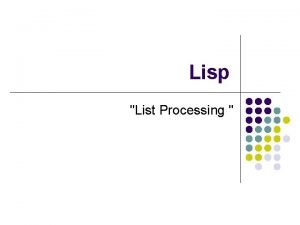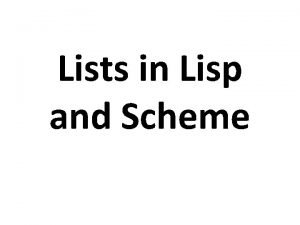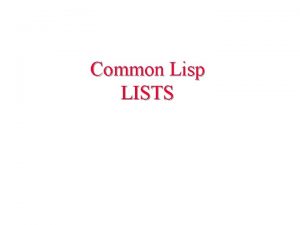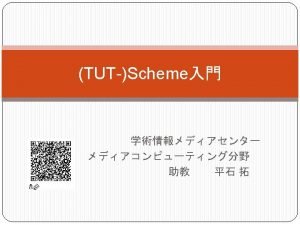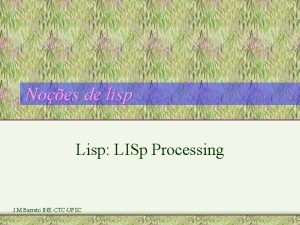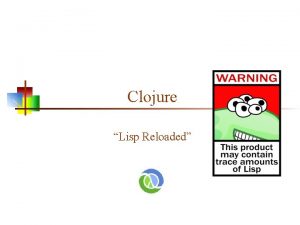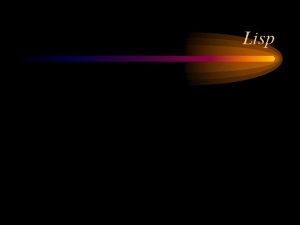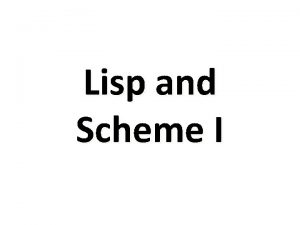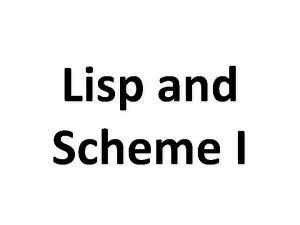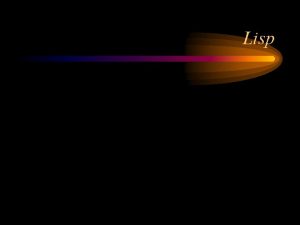Lisp List Processing Lisp history l John Mc











- Slides: 11

Lisp "List Processing "

Lisp history l John Mc. Carthy developed the basics behind Lisp during the 1956 Dartmouth Summer Research Project on Artificial Intelligence l He intended it as an algebraic LISt Processing (hence the name) language for artificial intelligence work l He showed how, given a handful of simple operators and anotation for functions, you can build a whole programming language.

Design Goals l Formalism for developing a theory of computation l Programming language for numerical and logical problems l Symbolic manipulation of expressions and sentences

Characteristics l LISP was one of the earliest high-level programming languages and introduced many ideas such as garbage collection, recursive functions, symbolic expressions, and dynamic type-checking l Interest in symbolic computation influenced design l Use of simple machine model l Attention to theoretical considerations Recursive function theory, Lambda calculus

Distinctive Characteristics Not C, C++, Java: a chance to think differently l LISt Processing: the ancestor of all functional languages l Lisp is good at handling lists of things, and the abstraction level is higher than C/C++ normally allows you to get to. l

Relative Speeds of 5 language

Description of Lisp l LISP is usually used as an interpreted language. l The interpreter runs what is known as a read- evaluates-print loop.

Description of Lisp l l The two most important kinds of objects in LISP for you to know about are atoms and lists. Atoms are represented as sequences of characters of reasonable length. Such as : 34 or join. Lists are recursively constructed from atoms Such as: (a john 34 c 3 po). The interpreter treats any list as containing the name of a function followed by the arguments to the function. Such as: (+ 2 13 45).

Defining Lisp Function Use defun to define your own functions in LISP. (defun <name> <parameter-list> <body>) l l Example: >(defun square (x) (* x x)) SQUARE >(square 2) 4

Example Code l reverse : Format: (reverse <list>) Reverse returns a list that contains all the elements of <list> in reversed order. l Example: > (reverse '(picard riker worf crusher)) (CRUSHER WORF RIKER PICARD) > (reverse '(picard riker worf crusher))) (PICARD RIKER WORF CRUSHER) l

Resources l l http: //faqs. org/faqs/lisp-faq/part 2/section-13. html http: //www. cc. gatech. edu/data_files/classes/cs 6390/slides/lisp. pdf http: //web. syr. edu/~aalarifi/Common%20 Lisp. pdf http: //norvig. com/python-lisp. html
 Lisp list processing
Lisp list processing Lisp add element to list
Lisp add element to list Common lisp association list
Common lisp association list Top-down processing
Top-down processing Bottom up processing vs top down processing
Bottom up processing vs top down processing Bottom up processing example
Bottom up processing example Point processing operations
Point processing operations Secondary processed food
Secondary processed food Point processing
Point processing Histogram processing in digital image processing
Histogram processing in digital image processing Parallel processing vs concurrent processing
Parallel processing vs concurrent processing Neighborhood processing in digital image processing
Neighborhood processing in digital image processing
